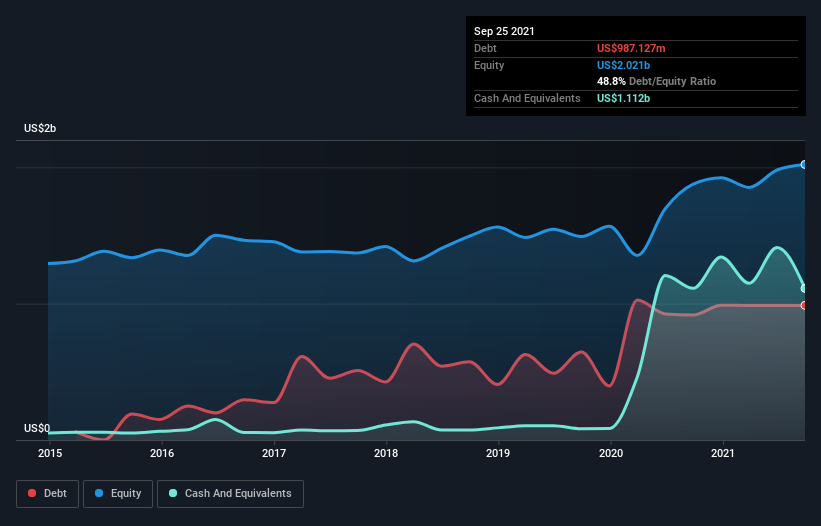These 4 Measures Indicate That Tractor Supply (NASDAQ:TSCO) Is Using Debt Safely
Howard Marks put it nicely when he said that, rather than worrying about share price volatility, 'The possibility of permanent loss is the risk I worry about... and every practical investor I know worries about.' So it seems the smart money knows that debt - which is usually involved in bankruptcies - is a very important factor, when you assess how risky a company is. We can see that Tractor Supply Company (NASDAQ:TSCO) does use debt in its business. But the real question is whether this debt is making the company risky.
What Risk Does Debt Bring?
Generally speaking, debt only becomes a real problem when a company can't easily pay it off, either by raising capital or with its own cash flow. If things get really bad, the lenders can take control of the business. However, a more common (but still painful) scenario is that it has to raise new equity capital at a low price, thus permanently diluting shareholders. Of course, the upside of debt is that it often represents cheap capital, especially when it replaces dilution in a company with the ability to reinvest at high rates of return. When we think about a company's use of debt, we first look at cash and debt together.
Check out our latest analysis for Tractor Supply
How Much Debt Does Tractor Supply Carry?
You can click the graphic below for the historical numbers, but it shows that as of September 2021 Tractor Supply had US$987.1m of debt, an increase on US$917.2m, over one year. However, its balance sheet shows it holds US$1.11b in cash, so it actually has US$124.6m net cash.
How Strong Is Tractor Supply's Balance Sheet?
According to the last reported balance sheet, Tractor Supply had liabilities of US$2.05b due within 12 months, and liabilities of US$3.68b due beyond 12 months. On the other hand, it had cash of US$1.11b and US$6.83m worth of receivables due within a year. So its liabilities total US$4.61b more than the combination of its cash and short-term receivables.
Of course, Tractor Supply has a titanic market capitalization of US$26.2b, so these liabilities are probably manageable. Having said that, it's clear that we should continue to monitor its balance sheet, lest it change for the worse. Despite its noteworthy liabilities, Tractor Supply boasts net cash, so it's fair to say it does not have a heavy debt load!
Another good sign is that Tractor Supply has been able to increase its EBIT by 25% in twelve months, making it easier to pay down debt. When analysing debt levels, the balance sheet is the obvious place to start. But ultimately the future profitability of the business will decide if Tractor Supply can strengthen its balance sheet over time. So if you're focused on the future you can check out this free report showing analyst profit forecasts.
Finally, a business needs free cash flow to pay off debt; accounting profits just don't cut it. While Tractor Supply has net cash on its balance sheet, it's still worth taking a look at its ability to convert earnings before interest and tax (EBIT) to free cash flow, to help us understand how quickly it is building (or eroding) that cash balance. During the last three years, Tractor Supply produced sturdy free cash flow equating to 77% of its EBIT, about what we'd expect. This cold hard cash means it can reduce its debt when it wants to.
Summing up
Although Tractor Supply's balance sheet isn't particularly strong, due to the total liabilities, it is clearly positive to see that it has net cash of US$124.6m. And it impressed us with free cash flow of US$746m, being 77% of its EBIT. So is Tractor Supply's debt a risk? It doesn't seem so to us. There's no doubt that we learn most about debt from the balance sheet. However, not all investment risk resides within the balance sheet - far from it. We've identified 2 warning signs with Tractor Supply , and understanding them should be part of your investment process.
At the end of the day, it's often better to focus on companies that are free from net debt. You can access our special list of such companies (all with a track record of profit growth). It's free.
This article by Simply Wall St is general in nature. We provide commentary based on historical data and analyst forecasts only using an unbiased methodology and our articles are not intended to be financial advice. It does not constitute a recommendation to buy or sell any stock, and does not take account of your objectives, or your financial situation. We aim to bring you long-term focused analysis driven by fundamental data. Note that our analysis may not factor in the latest price-sensitive company announcements or qualitative material. Simply Wall St has no position in any stocks mentioned.
Have feedback on this article? Concerned about the content? Get in touch with us directly. Alternatively, email editorial-team (at) simplywallst.com.



